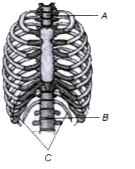What is significance of respiration ?
Step-by-Step Solution:
1. Definition of Respiration:
- Respiration is the biochemical process in which organisms convert oxygen and glucose into energy, carbon dioxide, and water. This process occurs at the cellular level and is essential for life.
2. Energy Production:
- One of the primary significances of respiration is that it provides energy for various biological processes. This energy is crucial for the biosynthesis of macromolecules such as carbohydrates, lipids, and proteins, which are vital for cell structure and function.
3. Movement and Locomotion:
- The energy generated from respiration is also utilized for movement and locomotion in organisms. This includes everything from muscle contractions in animals to the movement of cilia and flagella in microorganisms.
4. Industrial Applications:
- Respiration has significant industrial applications, particularly in processes that involve fermentation. For example, anaerobic respiration is used in industries like distilleries and bakeries to produce products such as alcohol, vitamins, and antibiotics. This shows that respiration is not only important for living organisms but also has practical applications in various industries.
5. Overall Importance:
- In summary, respiration is significant because it provides energy for cellular processes, supports movement, and has various applications in industry, making it essential for both living organisms and human activities.
- Respiration is the biochemical process in which organisms convert oxygen and glucose into energy, carbon dioxide, and water. This process occurs at the cellular level and is essential for life.
- One of the primary significances of respiration is that it provides energy for various biological processes. This energy is crucial for the biosynthesis of macromolecules such as carbohydrates, lipids, and proteins, which are vital for cell structure and function.
- The energy generated from respiration is also utilized for movement and locomotion in organisms. This includes everything from muscle contractions in animals to the movement of cilia and flagella in microorganisms.
- Respiration has significant industrial applications, particularly in processes that involve fermentation. For example, anaerobic respiration is used in industries like distilleries and bakeries to produce products such as alcohol, vitamins, and antibiotics. This shows that respiration is not only important for living organisms but also has practical applications in various industries.
- In summary, respiration is significant because it provides energy for cellular processes, supports movement, and has various applications in industry, making it essential for both living organisms and human activities.
Topper's Solved these Questions
- BOOK - MODERN PUBLICATIONCHAPTER - BREATHING AND EXCHANGE OF GASESEXERCISE - COMPETITION FILE (ADDITIONAL MULTIPLE CHOICE QUESTIONS:):30videos
BREATHING AND EXCHANGE OF GASES
- BOOK - MODERN PUBLICATIONCHAPTER - BODY FLUIDS AND CIRCULATION EXERCISE - Chapter Practice Test15videos
BODY FLUIDS AND CIRCULATION
- BOOK - MODERN PUBLICATIONCHAPTER - CELL : THE UNIT OF LIFE EXERCISE - Chapter Practice Test (Section-E)1videos
CELL : THE UNIT OF LIFE
Similar Questions
What is significance of respiratory pigment in respiration ?
View SolutionWhat is significance of BOD?
View SolutionWhat is significance of IUDs.
View Solution
What is the significance of C?View SolutionGive the significance of respiration.
View SolutionWhat is chloride shift ? Write its significance during respiration.
View SolutionWhat is significance of decomposers in an ecosystem.
View SolutionWhat is the significance of recombination?
View SolutionWhat is the significance of nodulation index?
View SolutionWhat is significance of meiosis-II?
View Solution

